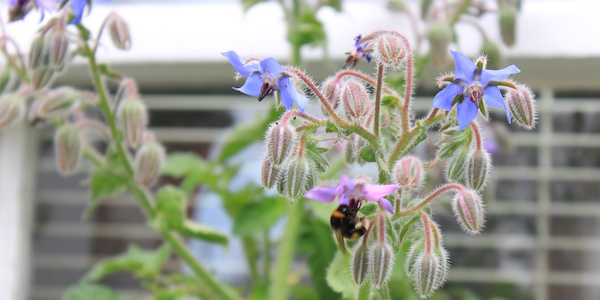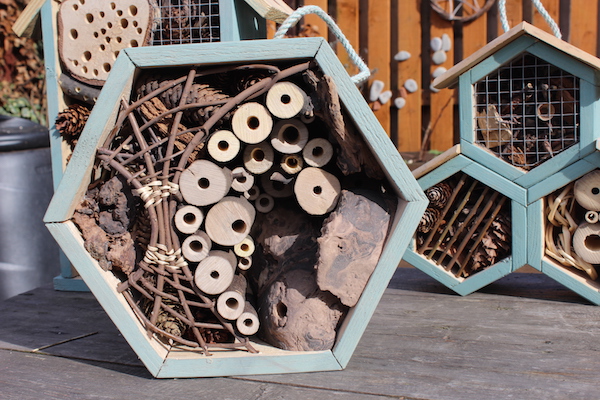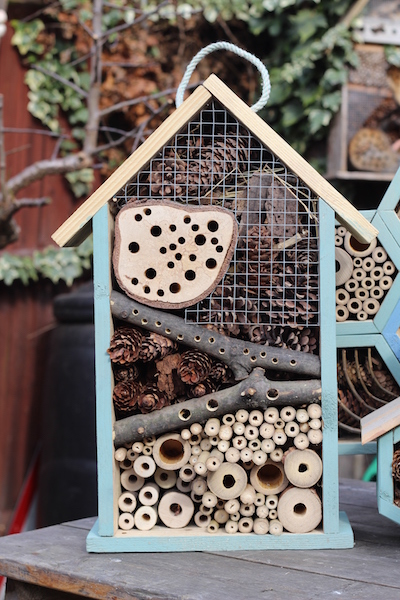How to make a bee home that really works

If you've only got a tiny growing space in the city, is there anything you can do to help bees? The answer is yes! I met up with Kate Bradbury, BBC wildlife expert and author of the The Wildlife Gardener, to find out what you can do for bees in a small urban space like a balcony, a few window sills or a small patch of concrete. Bees in cities commonly have a shortage of both of food and nesting places, says Kate. You can help by growing flowers (Kate recommends some good ones for bees below) and by making a home for solitary bees (watch how in the video). If you're wondering how you can make your bee hotel look more beautiful than the one I made in the video (!), check out the pictures of Marta Zientek's hotels - and see her tips for what to use at the bottom of the page.
Create a solitary bee home
You may be wondering, like I was, if insect homes actually work. According to Kate, although some can be gimmicky, solitary bee homes do. In the video below, she explains why solitary bees are in desperate need of more nesting places in the city. She shows how to make a small home for them. These homes are easy to make and take up very little space. All you need is a wall that gets sun in the morning on which to hang them.
Update: Preventing pests and disease
Once you've made your bee home, David Coles (reader of this blog), adds this advice from a volunteer at the Bumblebee Conservation Trust (thanks David): "The single most important thing with a bee hotel is that it should be cleaned out every year, all the pupae removed and cleaned as well and then presented for release the following year. With new materials installed every year for the bees to return to, otherwise your bee hotel will become infested with parasites and full of nothing but dead bees. Cleanliness and an annual routine are vital to maintain the health of the colony." I contacted the Bumblebee Conservation Trust for more information on how to do this and they suggested this excellent article. If you decide to make a bee home, do please take a look at this - it is full of wise and useful information.
Choose the right flowers for bees
Some flowers are more nutritious for bees than others, explains Kate. Good choices for bees in the edible container garden include:
- Borage flowers refill with nectar every two minutes - and so offer a nearly constant supply for bees. The small leaves are also edible and the flowers look amazing in summer drinks.
- Legumes have particularly nutritious pollen, high in protein. This can help bees grow strong and healthy. Legumes include the excellent (and delicious) container crops like French beans, runner beans, and peas (go for mange tout type peas in containers). Or you can grow birds foot trefoil or clover in your pots - they look pretty and, if you dig them in, they will add fertility as they fix nitrogen from the air (they are sometimes called "green manures" for this reason).
- Pot marigold (calendula), loved by many beneficial insects, including bees. The flower petals are edible and look great in salads.
- An apple tree or a kilmarnock willow tree - bees will love the blossom, a great choice if you've got space for a big pot.

Borage flowers are a magnet for bees. They refill with nectar every two minutes.
How to make a beautiful insect hotel
The bee home shown in the video will work fine but won't win any art competition, I'll be the first to admit! (Made myself in a rush one evening). But they can be really beautiful - as Marta Zientek shows us below, thank you for sharing Marta. (To see more of Marta and her partner, Wojciech, creative projects, do check out their Facebook Page.)

Bee and insect hotel made by Marta Zientek and Wojciech.
Here are Marta's tips to help you recreate one of her beautiful homes. "Firstly you need to find some materials, and the more you use recycled or reclaimed materials the better. If you want to make a hanging insect hotel you will need to make a wooden box. For this you can use a pallet wood, there is always plenty around. Then going for a walk to the park or woods where you can find lots of natural materials it's a good idea, look for pine cons, old bark, sticks, small pieces of dead wood, dried grass, straw and leaves, this is really great acctivity to do with your kids outdoors...other than this you can also use pieces of broken clay pot or broken tea cup, coconut shells or roof tiles. Try to use natural materials so the insects are familiar with the smell and texture and the environment is healthy for them. Once you have a box, with back wall blocked start filling it with the materials you have collected, try to make lots of segments and compartments, different in size and shape, each compartment can be stuffed with natural materials so variety of insects can enjoy it. Drill few wholes in the wood pieces, use bamboo canes, they naturally have wholes in ,or dried sticks bundled loosely, so insects can travel inside them, this will provide somewhere for insects to lay eggs or to hibernate in. Secure elements with the nails,string or wire so it stays in place, hang it in the garden, and wait for your guests. The whole design really depends on your imagination, you can make it really simple or give it more artistic look but what matters the most is creating supportive environment for the important pollinating species. Maybe make another one and give it to your friend as a present!"

Another of Marta Zientek and Wojciech's creations using found and recycled materials.
Your turn
Have you made any sort of insect home for your growing space? I'd love to hear about it in the comments. Or if you decide to make your own, I'd love to hear how it works out - if you fancy emailing me a pic, send it to mark@verticalveg.org.uk.

29 comments
Leave a comment